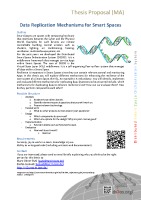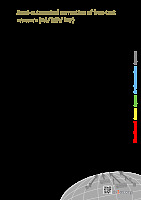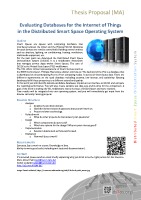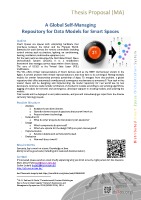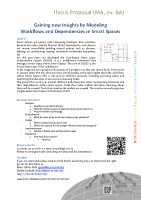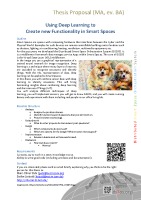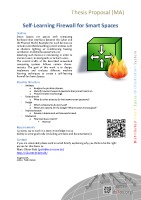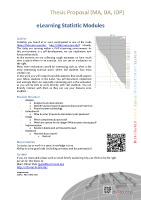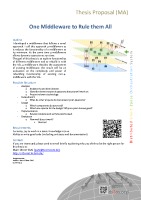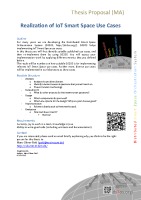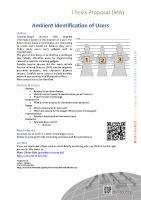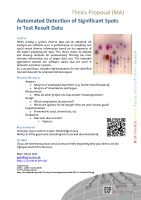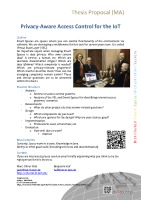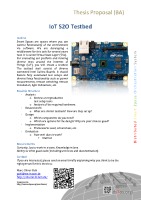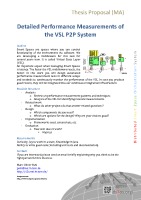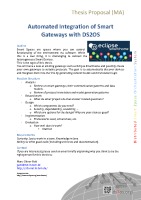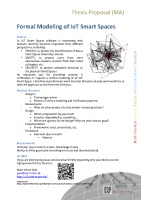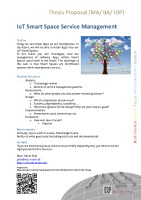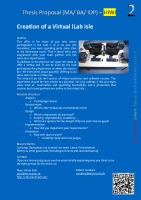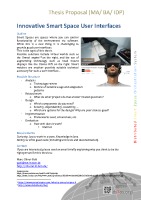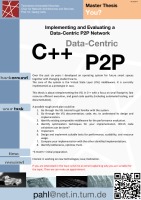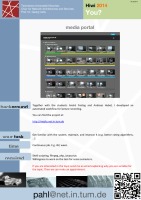[https://pahl.de/?site=__open]
Internet of Things Smart Space Research Team (IoT-s2o)
Open Thesis/ Student Assistant positions
If you are a very good student with decent software development skills and joy in the orchestration of smart spaces, make an appointment and drop in.
Below, you find a list of currently open topics. Here is a shorter overview. They give you an idea of areas, we are interested in working together with you.
If you have your own topic that might be interesting to us, also make an appointment and tell us more.
Semi-automated correction of free-text answers ¶
The iLab is a series of hands-on lab courses on Computer Networks and Distributed Systems that follows the iLab Concept [1]. From 2003-2020 more than 2000 students participated in one of the iLabs that run currently on three universities in Munich and Tübingen in Germany, and Sydney in Australia.
The iLab workflow [1] aims at providing the best possible learning experience at scale. The most expensive remaining work for the “at scale” factor is the manual correction of the free text answers given by the students.
In this thesis, you will work on support functionality for enabling a semi-automatic correction of student free text answers.
The iLab workflow [1] aims at providing the best possible learning experience at scale. The most expensive remaining work for the “at scale” factor is the manual correction of the free text answers given by the students.
In this thesis, you will work on support functionality for enabling a semi-automatic correction of student free text answers.
Evaluating Databases for the Internet of Things in the Distributed Smart Space Operating System ¶
Smart Spaces are spaces with computing hardware that interfaces between the Cyber and the Physical World. Examples for such devices are remote controllable building control entities such as shutters, lighting, air conditioning, heating, ventilation, multimedia equipment, etc.
For the past years we developed the Distributed Smart Space Orchestration System (DS2OS). It is a middleware framework that manages service Apps within Smart Spaces. The core of DS2OS is the Virtual State Layer (VSL) middleware.
The VSL offers virtual representations of Smart Devices such as the NEST thermometer, Philipps Hue lamps, shutter controls etc. The backend of the VSL is a database that is distributed on all participating Peer-to-Peer computing nodes. It stores all Smart Space data. There are different requirements on the used database including security, low latency, and scalability. Existing databases fulfill these properties to a different extend and quality.
In this work you will identify suitable candidate databases, implement an interface to DS2OS and compare the resulting performance. You will also create suitable test data sets and metrics for the comparison. A goal of the work is making the VSL middleware that is the base of DS2OS faster and more resilient.
Your results will be integrated into our operating system, and you will immediately get input from the diverse currently running projects.
For the past years we developed the Distributed Smart Space Orchestration System (DS2OS). It is a middleware framework that manages service Apps within Smart Spaces. The core of DS2OS is the Virtual State Layer (VSL) middleware.
The VSL offers virtual representations of Smart Devices such as the NEST thermometer, Philipps Hue lamps, shutter controls etc. The backend of the VSL is a database that is distributed on all participating Peer-to-Peer computing nodes. It stores all Smart Space data. There are different requirements on the used database including security, low latency, and scalability. Existing databases fulfill these properties to a different extend and quality.
In this work you will identify suitable candidate databases, implement an interface to DS2OS and compare the resulting performance. You will also create suitable test data sets and metrics for the comparison. A goal of the work is making the VSL middleware that is the base of DS2OS faster and more resilient.
Your results will be integrated into our operating system, and you will immediately get input from the diverse currently running projects.
A Global Self-Managing Repository for Data Models for Smart Spaces (MA) ¶
Smart Spaces are spaces with computing hardware that interfaces between the Cyber and the Physical World. Examples for such devices are remote controllable building control entities such as shutters, lighting, air conditioning, heating, ventilation, multimedia equipment, etc.
For the past years we developed the Distributed Smart Space Orchestration System (DS2OS). It is a middleware framework that manages service Apps within Smart Spaces. The core of DS2OS is the Virtual State Layer (VSL) middleware.
The VSL offers virtual representations of Smart Devices such as the NEST thermometer shown in the figure. A central problem with virtual representations is that they have to be converged. Having multiple models for similar functionality prevents portability of Apps. To mitigate from this problem, a global repository that offers automated crowdsourced convergence mechanisms is envisioned. Your task in this master thesis will be designing and implementing the model repository for real world use by real developers. Concrete tasks include verification of checked in models according to our existing algorithms, tagging of models for retrieval and convergence, developer support in creating models, and securing the models.
Your results will be deployed to our public website, and you will immediately get input from the diverse currently running projects.
For the past years we developed the Distributed Smart Space Orchestration System (DS2OS). It is a middleware framework that manages service Apps within Smart Spaces. The core of DS2OS is the Virtual State Layer (VSL) middleware.
The VSL offers virtual representations of Smart Devices such as the NEST thermometer shown in the figure. A central problem with virtual representations is that they have to be converged. Having multiple models for similar functionality prevents portability of Apps. To mitigate from this problem, a global repository that offers automated crowdsourced convergence mechanisms is envisioned. Your task in this master thesis will be designing and implementing the model repository for real world use by real developers. Concrete tasks include verification of checked in models according to our existing algorithms, tagging of models for retrieval and convergence, developer support in creating models, and securing the models.
Your results will be deployed to our public website, and you will immediately get input from the diverse currently running projects.
Gaining new Insights by Modeling Workflows and Dependencies in Smart Spaces (MA, eventually BA) ¶
For the past years we developed the Distributed Smart Space Orchestration System (DS2OS). It is a middleware framework that manages service Apps within Smart Spaces. The core of DS2OS is the Virtual State Layer (VSL) middleware.
In the image you see a graphical illustration of a program run that was shown by Sir Tony Hoare in autumn 2016. The VSL allows to draw similar graphs and to get insights about the workflows within Smart Spaces. This is relevant for different purposes including providing safety and optimizing the allocation of services to computing nodes.
The goal of this work is to analyze different techniques that allow representing processes and their dependencies within smart spaces. Tools that create models and allow reasoning about them will be created. Tools that visualize the models are created. The results are used to get new insights about Smart Space Orchestration (S2O).
In the image you see a graphical illustration of a program run that was shown by Sir Tony Hoare in autumn 2016. The VSL allows to draw similar graphs and to get insights about the workflows within Smart Spaces. This is relevant for different purposes including providing safety and optimizing the allocation of services to computing nodes.
The goal of this work is to analyze different techniques that allow representing processes and their dependencies within smart spaces. Tools that create models and allow reasoning about them will be created. Tools that visualize the models are created. The results are used to get new insights about Smart Space Orchestration (S2O).
Using Deep Learning to Create new Functionality in Smart Spaces (MA, eventually BA) ¶
For the past years we developed the Distributed Smart Space Orchestration System (DS2OS). It is a middleware framework that manages service Apps within Smart Spaces. The core of DS2OS is the Virtual State Layer (VSL) middleware.
In the image you see a graphical representation of a trained neural network for image recognition. Deep learning is a technique where many layers of neurons are cascaded to recognize structures and identify things. With the VSL representation of data, deep learning can be applied to Smart Spaces.
In this thesis you will combine sensor data with deep learning to identify situations. This will bring fascinating insights about combining deep learning and the Internet of Things (IoT).
You will analyze different techniques of deep learning, you will implement sensors, you will get to know DS2OS, and you will create running demos and experiment with them including real people in our office living lab.
In the image you see a graphical representation of a trained neural network for image recognition. Deep learning is a technique where many layers of neurons are cascaded to recognize structures and identify things. With the VSL representation of data, deep learning can be applied to Smart Spaces.
In this thesis you will combine sensor data with deep learning to identify situations. This will bring fascinating insights about combining deep learning and the Internet of Things (IoT).
You will analyze different techniques of deep learning, you will implement sensors, you will get to know DS2OS, and you will create running demos and experiment with them including real people in our office living lab.
Data Replication Mechanisms for Smart Spaces (MA) ¶
Smart Spaces are spaces with computing hardware that interfaces between the Cyber and the Physical World. Examples for such devices are remote controllable building control entities such as shutters, lighting, air conditioning, heating, ventilation, multimedia equipment, etc.
For the past years we developed the Distributed Smart Space Orchestration System (DS2OS). It is a middleware framework that manages service Apps within Smart Spaces. The core of DS2OS is the Virtual State Layer (VSL) middleware. It is a self-organizing Peer-to-Peer system that manages all data within a Smart Space.
Resilience is important in Smart Spaces since they can contain relevant control and monitoring Apps. In this thesis you will explore different mechanisms for enhancing the resilience of the core system of a Smart Space, the VSL. An example is K-redundancy. You will identify, implement and evaluate different mechanisms for replicating data. Questions to be answered include, which mechanisms for duplicating data to enhance resilience exist? How can we evaluate them? How do they perform compared to each other?
For the past years we developed the Distributed Smart Space Orchestration System (DS2OS). It is a middleware framework that manages service Apps within Smart Spaces. The core of DS2OS is the Virtual State Layer (VSL) middleware. It is a self-organizing Peer-to-Peer system that manages all data within a Smart Space.
Resilience is important in Smart Spaces since they can contain relevant control and monitoring Apps. In this thesis you will explore different mechanisms for enhancing the resilience of the core system of a Smart Space, the VSL. An example is K-redundancy. You will identify, implement and evaluate different mechanisms for replicating data. Questions to be answered include, which mechanisms for duplicating data to enhance resilience exist? How can we evaluate them? How do they perform compared to each other?
Self-Learning Firewall for Smart Spaces (MA) ¶
Smart Spaces are spaces with computing hardware that interfaces between the Cyber and the Physical World. Examples for such devices are remote controllable building control entities such as shutters, lighting, air conditioning, heating, ventilation, multimedia equipment, etc.
Attacking such devices is interesting in order to monitor users, to steal goods, or to harm users.
The control traffic of the described networked computing systems follows certain characteristics. The goal of this work is to design, implement and evaluate different machine learning techniques to create a self-learning firewall for Smart Spaces.
Attacking such devices is interesting in order to monitor users, to steal goods, or to harm users.
The control traffic of the described networked computing systems follows certain characteristics. The goal of this work is to design, implement and evaluate different machine learning techniques to create a self-learning firewall for Smart Spaces.
eLearning Statistic Modules (MA, BA, IDP) ¶
Probably you heard of or even participated in one of the iLabs (http://ilab.net.in.tum.de/, http://ilab2.net.in.tum.de/) already. The iLabs are running within a PHP eLearning environment. As this environment is a self-development, we can implement new functionality easily.
At the moment we are collecting rough estimates on how much time is spent where in an exercise. You can see an evaluation on the right.
Many more evaluations would be interesting such as, what is the most interesting exercise part?, where did students loos most credits?, etc.
In this work you will research possible statistics that could support your fellow students in the iLabs. You will document, implement and evaluate them. An especially interesting part is the evaluation as you will be able to work directly with real students. You can directly interact with them as they can use your features once enabled…
At the moment we are collecting rough estimates on how much time is spent where in an exercise. You can see an evaluation on the right.
Many more evaluations would be interesting such as, what is the most interesting exercise part?, where did students loos most credits?, etc.
In this work you will research possible statistics that could support your fellow students in the iLabs. You will document, implement and evaluate them. An especially interesting part is the evaluation as you will be able to work directly with real students. You can directly interact with them as they can use your features once enabled…
Tracking Bracelets vs. Privacy (MA) ¶
Devices that track users emerge. Some of such devices are bracelets. In this work we want to have a look at bracelets on the market and their capabilities. Our focus will be on possibilities to identify users by the data collected by the bracelets. Some bracelets we look at will go beyond the capabilities of classical fitness bracelets.
We will use a concrete bracelet as use case: the myo. We will try to identify users based on the sensor data of the bracelet during calibration and regular operation.
We will use a concrete bracelet as use case: the myo. We will try to identify users based on the sensor data of the bracelet during calibration and regular operation.
One Middleware to Rule them All (MA) ¶
I developed a middleware that follows a novel approach. I call this approach µ-middleware as it reduces the functionality of a middleware to its minimum. At the same time µ-middleware allows dynamic extension at run time.
The goal of this thesis is to explore functionality of different middleware and to rebuild it with the VSL µ-middleware. Besides the assessment of existing middleware, the result will be an evaluation on the complexity and power of rebuilding functionality of existing non-µ-middleware with the VSL.
The goal of this thesis is to explore functionality of different middleware and to rebuild it with the VSL µ-middleware. Besides the assessment of existing middleware, the result will be an evaluation on the complexity and power of rebuilding functionality of existing non-µ-middleware with the VSL.
Realization of IoT Smart Space Use Cases (MA) ¶
For many years we are developing the Distributed Smart Space Orchestration System (DS2OS, http://ds2os.org/). DS2OS helps implementing IoT Smart Space use cases.
In this thesis you will first identify suitable published use cases, and then re-implement them by using DS2OS. You will assess your implementation work by applying different metrics that you defined before.
The result will be numbers on how suitable DS2OS is for implementing relevant IoT Smart Space use cases. Further more, diverse use cases will be implemented in our laboratory as show cases.
In this thesis you will first identify suitable published use cases, and then re-implement them by using DS2OS. You will assess your implementation work by applying different metrics that you defined before.
The result will be numbers on how suitable DS2OS is for implementing relevant IoT Smart Space use cases. Further more, diverse use cases will be implemented in our laboratory as show cases.
Ambient Identification of Users (MA) ¶
Location-based services offer targeted information based on the location of a user. For future Smart Space environments it is interesting to locate users based on features they carry. Today many users carry gadgets such as smartphones.
The goal of this thesis is to develop a prototype that reliably identifies users by fingerprinting relevant properties including gadgets.
Suitable passive sensors for this work include Passive Infrared Sensors (PIR), electro-magnetic proximity detectors, and ultrasonic distance sensors. Suitable active sensors include wireless network access points and Bluetooth sniffers.
More sensors are to be identified.
The goal of this thesis is to develop a prototype that reliably identifies users by fingerprinting relevant properties including gadgets.
Suitable passive sensors for this work include Passive Infrared Sensors (PIR), electro-magnetic proximity detectors, and ultrasonic distance sensors. Suitable active sensors include wireless network access points and Bluetooth sniffers.
More sensors are to be identified.
A Way-Back Code Analysis Machine (MA) ¶
Did you ever contribute to a bigger software project? Did you write tests that do not only produce binary results (pass or fail)?
Performance evaluations are such kind of tests. Results of a performance test have a meaning when having an isolated look at them: an overall latency of 70ms for a task means that the task is perceived as interactive
by a human.
However, when looking at a series of results in correlation to code changes at the development of a software, a relative meaning is added: it becomes visible which impact certain code changes had on the overall latency of a system.
In an agile software development process such a knowledge can be used for continuously optimizing the latency of a software. The testing of a software is highly dependent on the test scenarios. A problem when adapting test scenarios at a certain point in time is that the historic dimension is missing for the data evaluation. Only test results from the time after the test was designed are available. With version control systems such as GIT or SVN, a software project brings its code history.
The goal of this thesis is to develop and implement an automated test workflow that runs a test scenario over past versions of the software project to gather historic data from
the software versions before the test was designed. As a second focus, suitable representations for the obtained data will be analyzed and developed. Graphs plotting the measured values over the revision history could already be a suitable visualization.
Performance evaluations are such kind of tests. Results of a performance test have a meaning when having an isolated look at them: an overall latency of 70ms for a task means that the task is perceived as interactive
by a human.
However, when looking at a series of results in correlation to code changes at the development of a software, a relative meaning is added: it becomes visible which impact certain code changes had on the overall latency of a system.
In an agile software development process such a knowledge can be used for continuously optimizing the latency of a software. The testing of a software is highly dependent on the test scenarios. A problem when adapting test scenarios at a certain point in time is that the historic dimension is missing for the data evaluation. Only test results from the time after the test was designed are available. With version control systems such as GIT or SVN, a software project brings its code history.
The goal of this thesis is to develop and implement an automated test workflow that runs a test scenario over past versions of the software project to gather historic data from
the software versions before the test was designed. As a second focus, suitable representations for the obtained data will be analyzed and developed. Graphs plotting the measured values over the revision history could already be a suitable visualization.
Automated Detection of Significant Spots in Test Result Data (MA) ¶
When testing a system, diverse data can be obtained. An example are software tests. A performance or scalability test could reveal diverse information based on the expertise
of the expert analyzing the data. This thesis wants to analyze and develop methods for automatically filtering the most relevant information out of larger data sets. The intended application domain are software stacks that are used in networks and other systems.
As a second focus, suitable representations for the identified relevant data will be analyzed and developed.
of the expert analyzing the data. This thesis wants to analyze and develop methods for automatically filtering the most relevant information out of larger data sets. The intended application domain are software stacks that are used in networks and other systems.
As a second focus, suitable representations for the identified relevant data will be analyzed and developed.
Privacy-Aware Access Control for the IoT (MA) ¶
Smart Spaces are spaces where you can control functionality of the environment via software. We are developing a middleware for this task for several years now. It is called Virtual State Layer (VSL).
An important aspect when managing Smart Spaces is data privacy. Who owns certain data? A service, a human, etc. Which are desirable dissemination ranges? Which are data lifetimes? Which complexity is needed? Which are privacy-relevant properties? Which metrics describe them? How can the emerging complexity remain usable? These and similar questions are to be answered within this thesis.
An important aspect when managing Smart Spaces is data privacy. Who owns certain data? A service, a human, etc. Which are desirable dissemination ranges? Which are data lifetimes? Which complexity is needed? Which are privacy-relevant properties? Which metrics describe them? How can the emerging complexity remain usable? These and similar questions are to be answered within this thesis.
Internet of Things/ Smart Space Orchestration Testbed (BA) ¶
Smart Spaces are spaces where you can control functionality of the environment via software. We are developing a middleware for this task for several years now. It is called Virtual State Layer (VSL).
For evaluating our platform and running diverse tests around the Internet of Things (IoT), you will create a testbed. The testbed shall consist of diverse connected Intel Galileo Boards. It should feature fully automated test setups and diverse fancy functionality such as power measurements, remote switching, remote installation, light indications, etc.
For evaluating our platform and running diverse tests around the Internet of Things (IoT), you will create a testbed. The testbed shall consist of diverse connected Intel Galileo Boards. It should feature fully automated test setups and diverse fancy functionality such as power measurements, remote switching, remote installation, light indications, etc.
Detailed Performance Measurements of the VSL P2P System (MA) ¶
Smart Spaces are spaces where you can control functionality of the environment via software. We are developing a middleware for this task for several years now. It is called Virtual State Layer (VSL).
An important aspect when managing Smart Spaces is latency. The faster the VSL middleware reacts, the better. In this work you will design automated performance measurement tests in different setups and testbeds to continuously monitor the performance of the VSL. In case you produce good results, they will be integrated into our continuous integration infrastructure.
An important aspect when managing Smart Spaces is latency. The faster the VSL middleware reacts, the better. In this work you will design automated performance measurement tests in different setups and testbeds to continuously monitor the performance of the VSL. In case you produce good results, they will be integrated into our continuous integration infrastructure.
Automated Integration of Smart Gateways with DS2OS (MA) ¶
Smart Spaces are spaces where you can control functionality of the environment via software. While this is a cool thing, it is challenging to connect the heterogeneous Smart Devices.
This is the topic of this thesis.
You will have a look at existing gateways such as Eclipse Smarthome and possibly create your own gateways to suitable protocols. The goal is to automatically discover devices and integrate them into the VSL by generating context models and translation logic.
This is the topic of this thesis.
You will have a look at existing gateways such as Eclipse Smarthome and possibly create your own gateways to suitable protocols. The goal is to automatically discover devices and integrate them into the VSL by generating context models and translation logic.
Formal Modeling of IoT Smart Spaces (MA) ¶
In IoT Smart Spaces software is interacting with humans. Security becomes important from different perspectives, including:
- PRIVACY, to protect the dissemination of data a Smart Space inherently collects.
- SAFETY, to protect users from their autonomous mowers, workers from their robot colleagues, etc.
- SECURITY, to protect unwanted intrusion to the physical Smart Spaces.
An important tool for providing security is verification. It requires a formal modeling of an IoT Smart Space. I did diverse preliminary work into that direction already and would like to take this approach to the next level with you...
- PRIVACY, to protect the dissemination of data a Smart Space inherently collects.
- SAFETY, to protect users from their autonomous mowers, workers from their robot colleagues, etc.
- SECURITY, to protect unwanted intrusion to the physical Smart Spaces.
An important tool for providing security is verification. It requires a formal modeling of an IoT Smart Space. I did diverse preliminary work into that direction already and would like to take this approach to the next level with you...
IoT Smart Space Service Management (MA, BA, IDP) ¶
Today we can install Apps on our smartphones. In the future, we will be able to install Apps into our IoT Smart Spaces.
In this thesis you will investigate, how the management of software Apps within Smart Spaces could work in the future. The challenge of this task is that Smart Spaces are distributed systems while smartphones are not...
In this thesis you will investigate, how the management of software Apps within Smart Spaces could work in the future. The challenge of this task is that Smart Spaces are distributed systems while smartphones are not...
Creation of a Virtual iLab Isle (MA, BA, IDP) + student assistantship ¶
This offer is for those of you who either participated in the iLab 1 or 2. As you will remember, you were spending quite some time in the laboratory room. That is good since you cooperated with your team partner and ran some nice experiments.
In addition to the physical lab space we want to offer a virtual one. It can be used by the iLab participants for preparation, or when the room is full. We even think about possibly offering to do some labs inside a virtual isle.
The virtual iLab isle will consist of virtual machines and software routers. The experience should be very similar to a physical isle (e.g. cabling…). We also want some kind of reservation and spawning mechanism, and a protection that ensures both team partners are online in the virtual isle...
In addition to the physical lab space we want to offer a virtual one. It can be used by the iLab participants for preparation, or when the room is full. We even think about possibly offering to do some labs inside a virtual isle.
The virtual iLab isle will consist of virtual machines and software routers. The experience should be very similar to a physical isle (e.g. cabling…). We also want some kind of reservation and spawning mechanism, and a protection that ensures both team partners are online in the virtual isle...
Innovative Smart Space User Interfaces (MA, BA, IDP) ¶
Smart Spaces are spaces where you can control functionality of the environment via software. While this is a cool thing, it is challenging to provide good user interfaces.
This is the topic of this thesis.
Possible solutions include virtual worlds such as the Unreal engine on the right, and the use of augmenting technology such as head mount displays like the Oculus Rift on the right. Smart watches are another possibly suitable technical accessory for such a user interface...
This is the topic of this thesis.
Possible solutions include virtual worlds such as the Unreal engine on the right, and the use of augmenting technology such as head mount displays like the Oculus Rift on the right. Smart watches are another possibly suitable technical accessory for such a user interface...
Implementing and Evaluating a Data-Centric P2P Network ¶
For the past years I developed an operating system for smart spaces together with different
students.
The system is implemented as prototype in Java.
This thesis is about implementing the architecture in C++ to get a highly performant, scalable,
small (footprint), and well documented, and tested implementation.
The implementation shall run on different architectures from embedded devices to PCs.
Major parts of the work are implementing the required compatibility, testing,
and evaluating the solution.
students.
The system is implemented as prototype in Java.
This thesis is about implementing the architecture in C++ to get a highly performant, scalable,
small (footprint), and well documented, and tested implementation.
The implementation shall run on different architectures from embedded devices to PCs.
Major parts of the work are implementing the required compatibility, testing,
and evaluating the solution.
Fully Automated Video Processing Workflow ¶
At media.net.in.tum.de you find the video platform I developed with my students Andre Freitag and Andreas Hubel.
We use it to offer students video feedback for their talks, and to provide lecture recordings.
If you are interested, you could become the new student maintainer of the project.
We use it to offer students video feedback for their talks, and to provide lecture recordings.
If you are interested, you could become the new student maintainer of the project.
Overview
- Semi-automated correction of free-text answers
- Evaluating Databases for the Internet of Things in the Distributed Smart Space Operating System
- A Global Self-Managing Repository for Data Models for Smart Spaces (MA)
- Gaining new Insights by Modeling Workflows and Dependencies in Smart Spaces (MA, eventually BA)
- Using Deep Learning to Create new Functionality in Smart Spaces (MA, eventually BA)
- Data Replication Mechanisms for Smart Spaces (MA)
- Self-Learning Firewall for Smart Spaces (MA)
- eLearning Statistic Modules (MA, BA, IDP)
- Tracking Bracelets vs. Privacy (MA)
- One Middleware to Rule them All (MA)
- Realization of IoT Smart Space Use Cases (MA)
- Ambient Identification of Users (MA)
- A Way-Back Code Analysis Machine (MA)
- Automated Detection of Significant Spots in Test Result Data (MA)
- Privacy-Aware Access Control for the IoT (MA)
- Internet of Things/ Smart Space Orchestration Testbed (BA)
- Detailed Performance Measurements of the VSL P2P System (MA)
- Automated Integration of Smart Gateways with DS2OS (MA)
- Formal Modeling of IoT Smart Spaces (MA)
- IoT Smart Space Service Management (MA, BA, IDP)
- Creation of a Virtual iLab Isle (MA, BA, IDP) + student assistantship
- Innovative Smart Space User Interfaces (MA, BA, IDP)
- Implementing and Evaluating a Data-Centric P2P Network
- Fully Automated Video Processing Workflow
